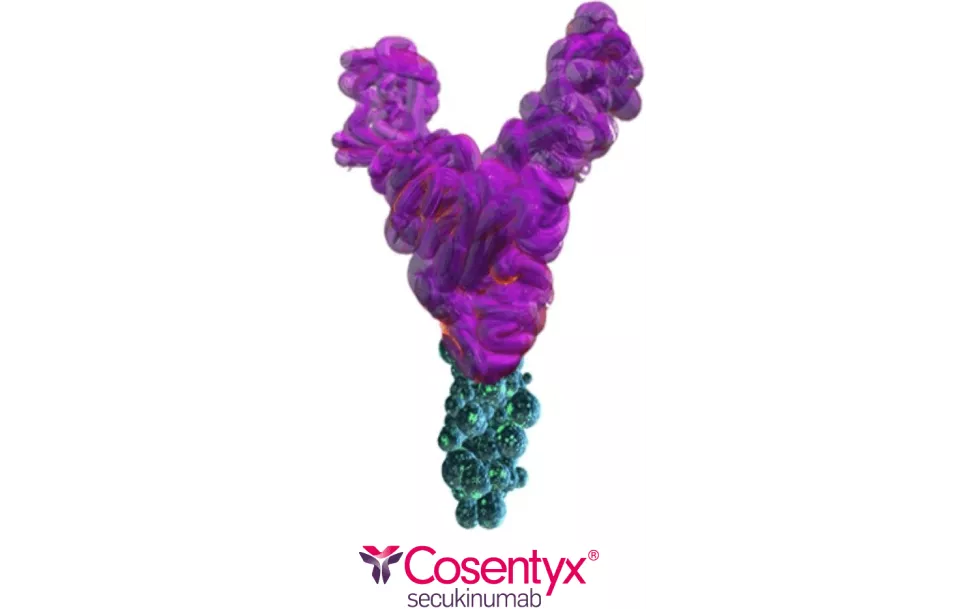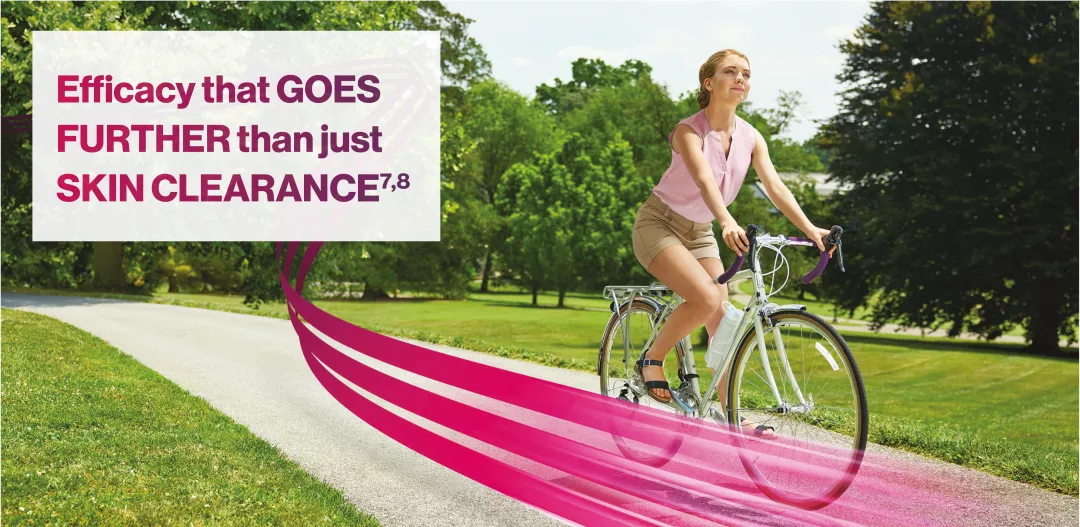Need more information?
Our dedicated team of Novartis representatives based throughout the UK are on hand to answer your local queries.
This page is intended for UK healthcare professionals and other relevant decision makers only. If you are a member of the public, please click here.
This portal is funded and owned by Novartis Pharmaceuticals UK Ltd and includes content approved by Novartis.
Adverse events reporting information can be found in the footer of this page.
Cosentyx is indicated for the treatment of moderate to severe plaque psoriasis (PsO) in adults, children and adolescents from the age of 6 years who are candidates for systemic therapy; active psoriatic arthritis (PsA) in adult patients (alone or in combination with methotrexate [MTX]) when the response to previous disease-modifying anti-rheumatic drug therapy has been inadequate; active moderate to severe hidradenitis suppurativa (HS; acne inversa) in adults with an inadequate response to conventional systemic HS therapy.1
Cosentyx is intended for use under the guidance and supervision of a physician experienced in the diagnosis and treatment of conditions for which Cosentyx is indicated.
Cosentyx as a biologic is the first and only fully-human, targeted, direct IL-17A inhibitor indicated in moderate to severe PsO and active moderate to severe HS1
Cosentyx inhibits IL-17A, a cornerstone cytokine that upregulates other pro-inflammatory molecules that play a key role in autoimmune and inflammatory diseases such as PsO, PsA and HS1–4
This image does not depict real patients. For illustrative purposes only.
The primary endpoint of the HS pivotal studies SUNSHINE (N=541) and SUNRISE (N=543) in adult patients with moderate to severe HS was clinical response (as measured by HiSCR), defined as a decrease in abscess and inflammatory nodule count by 50% or more with no increase in the number of abscesses or draining fistulae compared with baseline, of Cosentyx versus placebo at Week 16, assessed in the overall population. The primary endpoint was met for Cosentyx 300 mg Q2W in both SUNRISE and SUNSHINE trials (p=0.015 and p=0.007 respectively) and was met for Cosentyx 300 mg Q4W in SUNRISE (p=0.002) but not in SUNSHINE. Clinical response was sustained to Week 52 in both trials.5
This image does not depict a real patient. For illustrative purposes only.
SKIN CLEARANCE is meant by: 69% Psoriasis Area and Severity Index (PASI) 100, an exploratory endpoint, achieved in PsO patients receiving Cosentyx 300 mg (n=80) vs 22.4% of patients receiving narrowband ultraviolet B (nb-UVB) phototherapy (n=80) (p<0.0001) through Week 52. The primary endpoint of PASI 90 response at week 52 for Cosentyx 300 mg vs nb-UVB was met (91.1% vs 42.3% respectively, p<0.0001).7
FURTHER is meant by: 90% of PsO patients with PsA (n=191) taking Cosentyx 300 mg showed no radiographic progression through Year 2 (observational data, no statistical testing). The primary endpoint of proportion of patients achieving ACR20 response at Week 16 was met (Cosentyx 300 mg 62.6% vs placebo 27.4%, p<0.0001).8,9
The usual maintenance dose of Cosentyx for adults with moderate to severe HS or PsO is 300 mg monthly.1 Please see the PsO dosing page and HS dosing page for further details on initiation and maintenance dosing.
Therapeutic indications1
Cosentyx is indicated for the treatment of moderate to severe plaque psoriasis (PsO) in adults, children and adolescents from the age of 6 years who are candidates for systemic therapy; active psoriatic arthritis (PsA) in adult patients (alone or in combination with methotrexate [MTX]) when the response to previous disease-modifying anti-rheumatic drug therapy has been inadequate; active ankylosing spondylitis (AS) in adults who have responded inadequately to conventional therapy; active non-radiographic axial spondyloarthritis (nr-axSpA) with objective signs of inflammation as indicated by elevated C-reactive protein and/or magnetic resonance imaging evidence in adults who have responded inadequately to non-steroidal anti-inflammatory drugs; active moderate to severe hidradenitis suppurativa (HS; acne inversa) in adults with an inadequate response to conventional systemic HS therapy; active enthesitis-related arthritis (ERA) in patients 6 years and older (alone or in combination with MTX) whose disease has responded inadequately to, or who cannot tolerate, conventional therapy; active juvenile psoriatic arthritis (JPsA) in patients 6 years and older (alone or in combination with MTX) whose disease has responded inadequately to, or who cannot tolerate, conventional therapy.1
ACR, American College of Rheumatology; AS, ankylosing spondylitis; axSpA, non-radiographic axial spondyloarthritis; ERA, enthesitis-related arthritis; HCP, healthcare professional; HiSCR, hidradenitis suppurativa clinical response; HS, hidradenitis suppurativa; IL-17, interleukin-17; JPsA, juvenile psoriatic arthritis; MTX, methotrexate; nb-UVB, narrowband ultraviolet B; NICE, National Institute for Health and Care Excellence; nr-axSpA, non-radiographic axial spondyloarthritis; PASI, psoriatic area and severity index; PsA, psoriatic arthritis; PsO, plaque psoriasis; SIAQ, self-injection assessment questionnaire; SmPC, Summary of Product Characteristics.
*In the MATURE study, the usability of secukinumab 300 mg 2 ml autoinjector was evaluated in patients with psoriasis using the self-injection assessment questionnaire (SIAQ). The satisfaction with self-injection of secukinumab was 100% from baseline through Week 28; n=12/37 (32.4%) were ‘satisfied’ and n=25/37 (67.6%) were ‘very satisfied’.10
Cosentyx is to be administered by subcutaneous injection. Patients may self-inject Cosentyx, if properly trained and considered appropriate by the physician.1
Please refer to the SmPC for full details on method of administration.
References
Cosentyx® (secukinumab) Summary of Product Characteristics.
Miossec P, Kolls JK. Nat Rev Drug Discov 2012;11(10):763–776.
Mease P, McInnes I. Rheumatol Ther 2016;3(1):5–29.
Yin Y, et al. Arthritis Res Ther 2020;22(1):111.
Kimball AB, et al. Lancet 2023;401(10378):747–761.
National Institute for Health and Care Excellence. Secukinumab for treating moderate to severe hidradenitis suppurativa [TA935]. Available from: https://www.nice.org.uk/guidance/TA935 [Accessed June 2025].
Iversen L, et al. J Eur Acad Dermatol Venereol 2023;37(5):1004–1016.
Mease PJ, et al. RMD Open 2021;7(2):e001600.
Mease P, et al. Ann Rheum Dis 2018;77(6):890–897.
Sigurgeirsson B, et al. Dermatol Ther 2022;35(3):e15285.
UK | June 2025 | FA-11386098
Adverse events should be reported. Reporting forms and information can be found at www.mhra.gov.uk/yellowcard. Adverse events should also be reported to Novartis online through the pharmacovigilance intake (PVI) tool at www.novartis.com/report, or alternatively email [email protected] or call 01276 698370.




